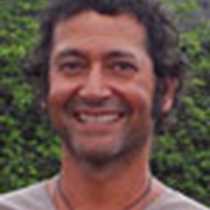Floreana Island
Floreana Island is the most populated island of the archipelago. It is located in a southeast of the archipelago and is made of eroded parasitic cones and a very old volcano. The springs of freshwater made it attractive to whalers and pirates in the past centuries. It was Darwin’s second island to visit and the place where he realized that many different species of land tortoises exist.
Before breakfast we visited Punta Cormorant, landing on a green beach rich in olivine, a.k.a. peridot, a semi-precious and small stone. We all agreed on the beauty of this emerald-looking sand. We also observed the rich vegetation around the salty lagoon that harbored flamingos and waders. The white sand, flour-like beach at the end of our trail was full of sea turtle tracks. After breakfast, we took a Zodiac ride around Champion Island, where we found many Floreana mockingbirds around the cacti and under the light rain. We also observed red-billed tropicbirds, swallow-tail gulls and a lot of boobies. Then, with our snorkeling gear on, we returned to see all the rest: tropical fish, sea lions, stingrays and sharks – all swimming near enough to us to give us the thrill of adventure.
Lunch helped us recover from the excitement and afterward our naturalist Ernesto delighted us all with an entertaining lecture on the life of Charles Darwin.
After lunch, kayaks where waiting for the brave ones, while the amateur mail-deliverers visited the old barrel of Post Office Bay. Here our guests mailed their postcards, emulating the old and free-of-charge procedure used by whalers hundreds of years before. They also took a large number of letters to be delivered by hand, all over the globe.
Some of us witnessed the local soccer match of our crewmembers, played bare-footed, and with a coconut (just joking). Some others went kayaking or for a Zodiac ride along the coastline. We observed sea lions barking, rays and dozens of green sea turtles sticking their heads outside the water.
On the way back, we had the opportunity to observe a very rare event in the tropics: a sundog, scientific name: parhelion, "beside the sun." It is an atmospheric phenomenon that creates bright spots of light in the sky, often on a luminous ring or halo on either side of the sun. Sundogs appear as a rainbow-colored patch of light to the left or right of the sun, 22° distant of it. Sundogs are made commonly of plate-shaped hexagonal ice crystals in high and cold cirrus clouds or, during very cold weather, by ice crystals called diamond dust drifting in the air at low levels. All of them conditions difficult to reproduce in Galápagos.
That was Floreana today, another day in paradise…




